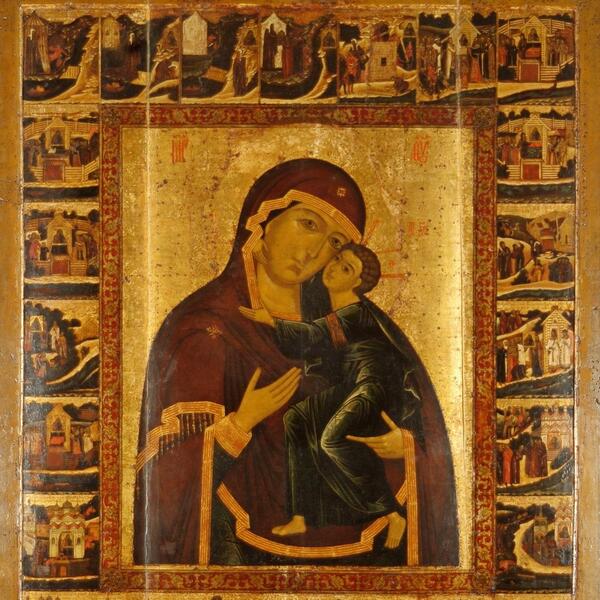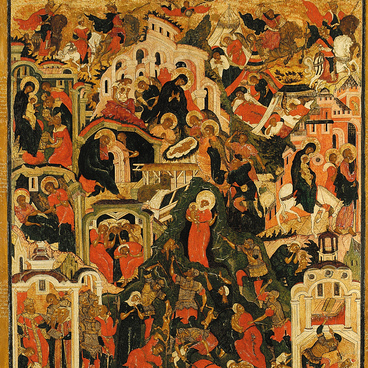Our Lady of Tolga is venerated in Yaroslavl as the protectress of the city. According to “The Legend of Our Lady of Tolga”, in 1314, Bishop Tryphon was traveling on the Volga River and spent one night near the place where the Tolga River joined the Volga. At night, the bishop had a vision: a bridge appeared in a pillar of light between the two banks of the Volga River. Taking a staff, Tryphon crossed the river and saw an image of the Virgin Mary with the Child Jesus in her arms floating two and a half meters above the ground. The bishop knelt down and for a long time, he prayed in tears to the Mother of God. After that, he returned to his group, leaving the staff at the place where he saw the icon. In the morning, his servants went to the specified location and discovered the bishop’s staff along with an icon of the Virgin Mary standing on the ground. Upon the bishop’s order, an area was arranged for a wooden church. It was constructed the very same day when local citizens found out about the miracle and came to help. Bishop Tryphon consecrated the church in honor of the Presentation of the Blessed Virgin Mary. Soon, the Presentation of the Virgin Mary Convent developed around the church.
In 1392, the miraculous powers of the icon were discovered after it started myrrh-streaming during a service. In 1553, Ivan the Terrible ordered to build a stone church on that spot. There are several variations of the legend of the wonderworking icon. In the mid-16th century, the short version was written, and the detailed story was created in the early 1650s, in the time of Hegumen Iol. In the same period, the icon was brought to two cross processions in Yaroslavl (in 1652 and 1654), and in 1655, the copy displayed in the exhibition was painted.
This icon is the earliest one of its kind that features “the miracles”, that is, the border scenes depicting the story of the icon. For the images of the Child Jesus and the Mother of God, the artist used dark blue, purple, and golden colors which are traditionally associated with majesty, eternity, and the unity of the Heavenly and the Earthly.
The images in the border scenes reflect the story of how the wonderworking icon was discovered, how the Tolga Convent was founded, along with a series of miracles involving healing, childbirth, resurrection, and rescue, as well as two miniatures showing prayer services in front of the icon and two depicting cross processions. The second last scene of the icon portrays the Yaroslavl Kremlin for the first time, with its wooden wall and towers, the houses of Yaroslavl citizens, and the Cathedral of the Dormition.
In 1392, the miraculous powers of the icon were discovered after it started myrrh-streaming during a service. In 1553, Ivan the Terrible ordered to build a stone church on that spot. There are several variations of the legend of the wonderworking icon. In the mid-16th century, the short version was written, and the detailed story was created in the early 1650s, in the time of Hegumen Iol. In the same period, the icon was brought to two cross processions in Yaroslavl (in 1652 and 1654), and in 1655, the copy displayed in the exhibition was painted.
This icon is the earliest one of its kind that features “the miracles”, that is, the border scenes depicting the story of the icon. For the images of the Child Jesus and the Mother of God, the artist used dark blue, purple, and golden colors which are traditionally associated with majesty, eternity, and the unity of the Heavenly and the Earthly.
The images in the border scenes reflect the story of how the wonderworking icon was discovered, how the Tolga Convent was founded, along with a series of miracles involving healing, childbirth, resurrection, and rescue, as well as two miniatures showing prayer services in front of the icon and two depicting cross processions. The second last scene of the icon portrays the Yaroslavl Kremlin for the first time, with its wooden wall and towers, the houses of Yaroslavl citizens, and the Cathedral of the Dormition.




